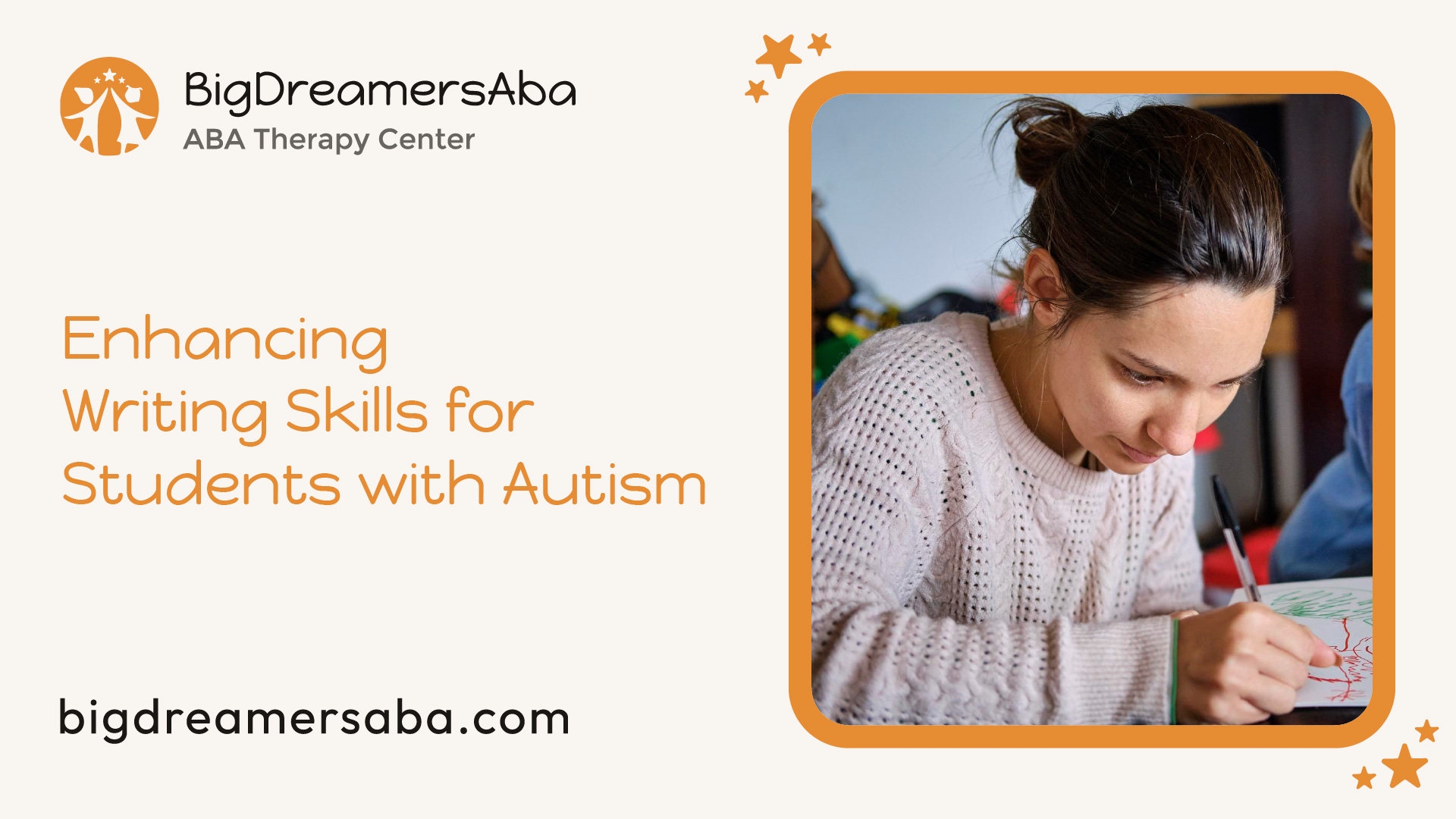Enhancing Writing Skills for Students with Autism
Explore effective strategies for teaching writing to students with autism and unlock their unique potential!


Understanding Writing Challenges
Common Writing Difficulties
Students with autism often encounter a range of writing difficulties that can hinder their ability to express their thoughts effectively. These challenges may include issues with organization and clarity, grammar and syntax, sensory sensitivities, anxiety and stress, as well as difficulties in editing and revising. Among the key obstacles faced by these individuals are:
Writing DifficultyDescriptionOrganization and ClarityTrouble structuring thoughts logically and expressing them clearly.Grammar and SyntaxChallenges in using proper grammatical structures and sentence formation.Fine Motor SkillsDifficulties in handwriting and typing that affect overall writing ability.Understanding NarrativesStruggles with grasping narrative structure and abstract concepts.Emotional RegulationAnxiety and stress can interfere with the writing process.
This table illustrates some of the common difficulties experienced by students on the autism spectrum. For more insights on associated conditions, consider reading about alexithymia: causes symptoms & treatments and pans/pandas in children with autism.
Impact on Communication
The writing difficulties faced by students with autism can significantly impact their overall communication skills. Communication is essential for expressing ideas, emotions, and needs. For some students, challenges in language development can lead to limited verbal communication abilities, making written expression even more critical.
As noted, autistic children show a wide range of communication skills. While some may possess advanced communication abilities, others may struggle with language, resulting in the need for tailored support. The deficits related to weak central coherence, theory of mind, and executive functioning are contributing factors to writing struggles [1].
Effective strategies for teaching writing to students with autism may include using visual supports like graphic organizers, which enhance comprehension and help students structure their ideas. For more methods of improving communication, explore the use of social stories for autism and the picture exchange communication system (pecs).
Strategies for Teaching Writing

Supporting students with autism in their writing journey requires tailored strategies that address their unique challenges. Effective approaches can enhance their writing skills and self-expression.
Pre-Writing Activities
Pre-writing activities play a crucial role in preparing students for successful writing experiences. These activities can include building vocabulary, enhancing language skills, and developing fine motor skills. Engaging students in fun and interactive exercises can create a supportive environment that boosts their confidence. For instance, practicing letter formation and using engaging vocabulary games helps reinforce language comprehension.
Pre-Writing ActivityPurposeVocabulary GamesBuilds language skillsFine Motor Skill ExercisesImproves handwriting abilitiesStory MappingEncourages organizational skills
Visual Supports and Tools
Visual supports and graphic organizers are valuable tools when teaching writing to students with autism. These aids provide a structured visual framework that enhances understanding and organization. By using graphic organizers, students can outline their thoughts, establish connections between ideas, and create a coherent structure for their writing.
Common visual supports include:
Visual ToolDescriptionGraphic OrganizersHelps to outline thoughts and structure writingPicture Exchange Communication System (PECS)Aids in expressing ideas using visuals (picture exchange communication system (pecs))StoryboardsGuides the storytelling process visually
Encouraging Creativity and Autonomy
Fostering creativity and autonomy is essential for empowering students with autism to express themselves through writing. Encouraging imaginative activities, allowing choices in writing topics, and providing positive reinforcement for accomplishments can significantly impact their self-confidence. Recognizing their efforts and achievements, no matter how small, can motivate them to continue improving their writing skills.
Establishing a collaborative environment between teachers, parents, and support teams can further support students. By nurturing their interests and incorporating them into writing tasks, educators can enhance engagement and creativity. Specific strategies include:
Encouragement StrategyDescriptionPositive ReinforcementRecognizes and celebrates achievementsChoice in TopicsAllows personal interests to guide writingCollaborative WritingEncourages teamwork in writing projects
These strategies can significantly enrich the writing experience for students with autism, helping them overcome challenges and build essential skills.
Overcoming Specific Challenges
When teaching writing to students with autism, several specific challenges can arise. Addressing these challenges effectively can greatly enhance the writing experience and foster greater engagement.
Fine Motor Skills Support
Many students with autism face difficulties related to fine motor skills, which can significantly impact their ability to write. Support tools such as soft grip pens and pencil grips can facilitate a better writing experience. Additionally, using adaptive writing tools like quiet keyboards can help individuals who are sensitive to the sounds of traditional writing instruments.
Support ToolDescriptionSoft Grip PensDesigned to reduce strain and enhance comfort during writing.Quiet KeyboardsMinimizes noise, making it easier for students with auditory sensitivities.Pencil GripsHelps with grip and control, making it easier for students to write.
These tools can provide the necessary assistance for students as they develop their writing proficiency.
Addressing Sensory Sensitivities
Students with autism may have sensory sensitivities that can hinder their writing capabilities. Creating a conducive writing environment is essential. Implementing quiet spaces, reducing distractions, and incorporating visual supports can help promote focus. Visual aids, such as graphic organizers, can also provide a structured approach to writing, allowing students to visualize their thoughts [2]. Tools like noise-canceling headphones can aid students who are easily distracted by ambient sound.
Sensory SupportDescriptionQuiet SpacesDesignated areas free from noise and clutter to enhance focus.Graphic OrganizersVisual structures to help students organize their ideas systematically.Noise-Canceling HeadphonesReduces distractions from surrounding sounds.
By minimizing sensory overload, students can concentrate better on their writing tasks.
Managing Anxiety and Stress
Anxiety and stress can be significant barriers for students with autism, particularly in writing tasks. By employing strategies such as deep breathing exercises and meditation, teachers can help students manage these feelings. Breaking writing assignments into smaller, more manageable chunks is also effective. This approach reduces overwhelming feelings and boosts confidence [3].
Management StrategyDescriptionDeep BreathingSimple exercises to promote relaxation before writing tasks.Chunking TasksDividing writing assignments into smaller segments to improve focus.MeditationMindfulness practices to help reduce anxiety levels.
Together, these strategies can provide a more supportive environment for students with autism, improving their overall writing experiences.
Utilizing Assistive Technology
Assistive technology has transformed how educators approach writing instruction for students with autism. These tools facilitate learning and help overcome specific writing challenges, making the writing process more accessible and enjoyable.
Assistive Tools Overview
A variety of assistive technology options can significantly benefit students with autism in developing their writing skills. Some of these tools include:
Assistive ToolDescriptionWord Prediction SoftwarePredicts words as the user types, reducing the demand for spelling and keyboarding skills.Voice-to-Text ToolsAllows users to dictate their writing, converting spoken words into text.Graphic OrganizersVisual aids that help organize thoughts and ideas before writing.First Author SoftwareA specialized program designed to support writing development in students with autism.Technology-Aided InstructionCombines various technologies to enhance learning experiences.
These tools not only provide valuable support but also promote independence among students as they write.
First Author Software Benefits
The First Author software stands out as a highly effective resource for students with autism. This evidence-based software has shown significant improvement in writing skills for users. Here are some of its key benefits:
By incorporating assistive tools like the First Author software, educators can effectively support students with autism in overcoming writing challenges and enhancing their writing experience overall. For further insights into teaching writing to students with autism, consider exploring resources on picture exchange communication system (PECS) or social stories for autism.
Enhancing Writing Skills

Writing instruction plays a crucial role in the overall development of students with autism, providing them with a means to communicate their thoughts, ideas, and emotions effectively. The following strategies can enhance writing skills for these students.
Tailored Instruction
Tailored instruction is vital for individuals with autism as it allows for personalized learning experiences that cater to their unique needs. Writing difficulties commonly faced by students include challenges with fine motor skills, organizing thoughts, grammar, and understanding abstract concepts.
Creating a structured environment for writing activities can help students feel more comfortable and confident. This predictability enhances their overall writing experience, making it easier for them to express themselves. Here are some strategies to implement tailored instruction:
StrategyDescriptionUse of graphic organizersHelps students collect and organize their thoughts visually before writing.Break tasks into smaller stepsEncourages manageable progress towards completing a writing assignment.Incorporate technologyTools such as word processors or speech-to-text software can assist students with writing difficulties.
Peer Collaboration
Peer collaboration is another effective approach for teaching writing to students with autism. Working alongside peers can foster communication skills, create a sense of belonging, and offer opportunities for social interaction. Collaborative writing activities encourage students to share ideas and develop their communication skills in a supportive environment.
Positive reinforcement and feedback are crucial components of this collaboration. Teachers can facilitate group writing projects or peer review sessions, allowing students to provide input on each other's work. Encouraging students to collaborate not only enhances their writing abilities but also nurtures essential life skills such as teamwork and problem-solving.
Promoting Communication through Writing
Promoting communication through writing helps students with autism express their thoughts and feelings. Writing serves as a powerful tool for self-expression, language development, and cognitive growth. By allowing students to communicate their ideas through writing, educators can enhance their learning experience.
Incorporating techniques such as social stories for autism or the picture exchange communication system (PECS) can be beneficial in enhancing students' writing skills. These resources support students in understanding narrative structures and develop critical writing components, such as character development and plot.
Furthermore, involving parents and the support team in the writing process helps ensure a consistent approach to teaching, leading to improved outcomes for students with autism [2]. By utilizing tailored instruction, peer collaboration, and promoting communication through writing, educators can effectively enhance writing skills in students with autism.
Specialized Instructional Approaches
Effective teaching strategies tailored for students with autism can significantly enhance their writing skills. Three specialized instructional approaches include chunking writing tasks, incorporating special interests, and leveraging visual stimuli.
Chunking Writing Tasks
Chunking involves breaking down writing assignments into smaller, manageable tasks. This strategy helps students with autism maintain focus, reduce feelings of overwhelm, and adopt a step-by-step approach to writing. As noted in AdinaABA, integrating graphic organizers during this process can further enhance comprehension and organization.
For example, a writing assignment can be divided into the following chunks:
Task StepDescriptionStep 1Brainstorm ideas related to the topic.Step 2Create an outline of the main points.Step 3Write a rough draft, focusing on one section at a time.Step 4Revise and edit the draft.Step 5Share the final piece.
This approach can help build independence in writing, provide clarity in task sequencing, and alleviate anxiety. It is crucial to recognize that students with autism may require more time on each step compared to their peers, facilitating gradual skill development.
Incorporating Special Interests
Integrating the special interests of students with autism into writing tasks can significantly boost engagement and motivation. Writing assignments that pertain to topics of personal relevance often yield better results than generic prompts [4].
For instance, if a student is passionate about dinosaurs, writing tasks could encompass:
Moreover, for more advanced writers, allowing students to select their own topics or organizing themed writing activities can further spark creativity and personal investment in their work.
Leveraging Visual Stimuli
Many students with autism are visual learners, making the use of visual stimuli a beneficial strategy in teaching writing. Visual aids, such as pictures and diagrams, can assist with various writing aspects like descriptive writing, characterization, and sensory engagement.
Additionally, multimedia resources such as videos can act as effective writing prompts, inspiring creativity and engagement in non-fiction tasks.
To further develop narrative skills, educators can utilize social stories that invite students to create characters and dialogues. Word games can also encourage creativity and shift focus from conventional writing skills, enhancing overall narrative and sentence structure abilities.
By applying these specialized instructional approaches, educators can cultivate a supportive and effective writing environment for students with autism. Incorporating chunking, special interests, and visual aids can substantially contribute to their writing development and overall confidence.
References
[2]:
[3]:
[4]:
Recent articles

Making Morning Time Stress Free for Kids With ABA Therapy

How ABA Programs Help Kids With Autism Develop Social Understanding
.jpg)